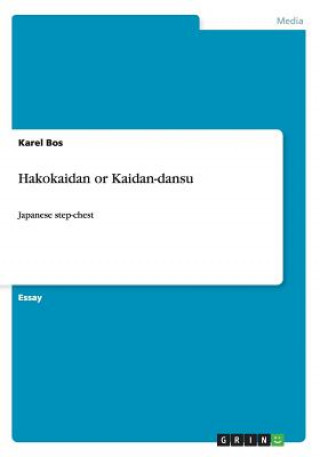
Code: 09071528
Hakokaidan or Kaidan-dansu
by Karel Bos
Essay from the year 2012 in the subject Art - Architecture / History of Construction, , language: English, abstract: The Japanese step-chest (kaidan-dansu or hakokaidan) is inextricably linked with the traditional 'machiya'§in Kyo ... more
- Language:
 English
English - Binding: Paperback
- Number of pages: 20
Publisher: Grin Publishing, 2014
- More about this

15.59 €
RRP: 17.26 €
You save 1.67 €

In stock at our supplier
Shipping in 8 - 10 days
You might also like
-

Sex Practice
10.05 € -4 % -

Teasing Master Takagi-san, Vol. 10
10.96 € -22 % -

Ghastly Tales from the Yotsuya kaidan
12.87 € -2 % -

Something Wicked from Japan
20.22 € -28 % -

Move Your Mood!
15.39 € -10 % -

Conversations With the Great Moviemakers of Hollywood's Golden Age at the American Film Institute
22.93 € -4 % -

Did You Ever Have A Family
15.39 € -19 %
Give this book as a present today
- Order book and choose Gift Order.
- We will send you book gift voucher at once. You can give it out to anyone.
- Book will be send to donee, nothing more to care about.
More about Hakokaidan or Kaidan-dansu
You get 39 loyalty points
 Book synopsis
Book synopsis
Essay from the year 2012 in the subject Art - Architecture / History of Construction, , language: English, abstract: The Japanese step-chest (kaidan-dansu or hakokaidan) is inextricably linked with the traditional 'machiya'§in Kyoto. In contrast to the 'minka', which are farmhouses, fishermen's houses and mountain dwellings, the§'machiya' is a merchants' and craftsmen's town-house, specifically in Kyoto, also often called 'kyo-machiya'.§Kyoto 'machiya' are traditional townhouses with distinctive Kyoto-style latticework doors and slatted§second-story windows (fig. 1+2). Machiya are already depicted on 17th century screens and they were still§built during the Taisho period and beyond until about 1936.§These wooden houses, where merchants and artisans both lived and worked, provided a space in front for§a store, in the middle for family quarters with small garden, and in the rear for workshops and warehouses.§Many of them can still be seen in the Gion district and they came to be regarded as one of the typical§traditional structures which characterise the ancient city of Kyoto.§Kyoto, Japan s capital of traditional culture, is one of the few Japanese cities that was spared from the§bombings of World War II, yet every year scores of 'machiya' are destroyed, victims of neglect and urban§redevelopment, thus rapidly erasing the traditional urban fabric. Luckily civic groups in Kyoto are working§hard to save the buildings that remain and to preserve this superb example of Kyoto vernacular architecture.§Typically the 'machiya' has a narrow front of about 5.5 to 6.4 m (3 to 3.5 ken ) and a depth of around 20 m§(11 ken ). As homes were taxed according to the size of the street frontage, this design originated from§economic necessity (fig. 16). However, as merchants became richer, they built larger 'machiya' and it is not§unusual to find a frontage of 6 and 7 ken (12.7 m).§The meaning of the modern concept of the 'module' has an exceptional antecedent in Japan, where for§hundreds of years the ordinary houses have been built on the basis of a modular order which is unique. [...]
 Book details
Book details
Book category Books in English The arts Architecture
15.59 €
- Full title: Hakokaidan or Kaidan-dansu
- Subtitle: Japanese step-chest
- Author: Karel Bos
- Language:
 English
English - Binding: Paperback
- Number of pages: 20
- EAN: 9783656822820
- ISBN: 3656822824
- ID: 09071528
- Publisher: Grin Publishing
- Weight: 54 g
- Dimensions: 254 × 178 × 1 mm
- Date of publishing: 24. October 2014
Trending among others
-

Louis I. Kahn
15.49 € -9 % -

Mystical Arts of Tibet
18.41 € -

Thought by Hand: The Architecture of Flores & Prats
30.89 € -4 % -

Living by the Ocean
35.92 € -14 % -

Brutal Poland
21.63 € -14 % -

S, M, L, XL
91.87 € -

Tiny House Design and Construction Guide
18.31 € -29 % -

Operating Manual for Spaceship Earth
17 € -6 % -

Kelly Wearstler
43.26 € -21 % -

Atlas of Brutalist Architecture
54.13 € -22 % -

New Nordic Houses
39.24 € -10 % -

Architecture in the 20th Century
58.96 € -25 % -

Patina Farm
32.50 € -19 % -

Borromini
51.92 € -

Atmospheres
41.65 € -15 % -

Brutal East Vol. II
27.87 € -6 % -

Building Construction Illustrated, Sixth Edition
57.35 € -

Spanish Style House
42.36 € -23 % -

Bibliostyle
29.98 € -16 % -

Japanese Architecture
25.05 € -18 % -

Spanish Colonial Style
37.53 € -28 % -

Designing Hollywood Homes
50.01 € -28 % -

Inseminations - Seeds for Architectural Thought
56.95 € -

Iwan Baan Japan Modern
34.91 € -

Leaping the Dragon Gate
222.19 € -

The Modern A-Frame
29.38 € -17 % -

Monotowns
29.07 € -

Eastern Blocks
21.32 € -12 % -

German Belt Buckles 1845-1945: Buckles of the Enlisted Soldiers
44.47 € -25 % -
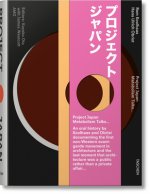
Koolhaas/Obrist. Project Japan. Metabolism Talks
47.09 € -10 % -

Architectural Detailing - Function, Constructibility, Aesthetics 3e
86.03 € -6 % -
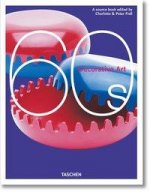
Decorative Art 60s
30.08 € -

101 Things I Learned in Architecture School
19.51 € -2 % -
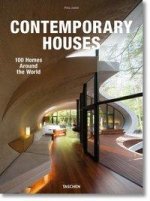
Contemporary Houses. 100 Homes Around the World
54.53 € -7 % -

Container and Modular Buildings
51.41 € -
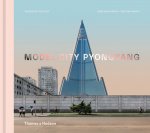
Model City Pyongyang
20.12 € -28 % -

Made in Norway
21.63 € -

Timeless Way of Building
48.09 € -29 % -

KOBENHAVN. Urban Architecture and Public Spaces
52.02 € -11 % -

Pugin's Gothic Ornament
12.27 € -23 % -

Decorative Art 70s
29.98 € -

Cape Cod Modern
34.51 € -23 % -

domus 1970s
30.68 € -

Rattan
52.02 € -19 % -

Modern Architecture and Interiors
31.79 € -8 % -
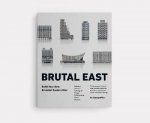
Brutal East (model Kits)
17.70 € -18 % -

Architecture Without Architects
30.48 € -

More Beautiful
35.31 € -22 % -

Tiny House Handbook
24.55 € -25 %
Collection points Bratislava a 2642 dalších
Copyright ©2008-24 najlacnejsie-knihy.sk All rights reservedPrivacyCookies


 15549 collection points
15549 collection points Delivery 2.99 €
Delivery 2.99 € 02/210 210 99 (8-15.30h)
02/210 210 99 (8-15.30h)